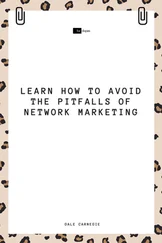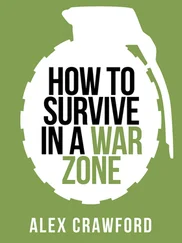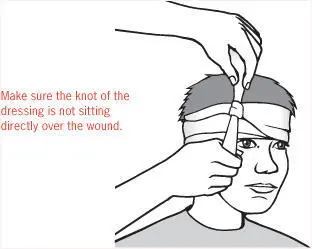
If the casualty is conscious and has no signs of brain injury, sit them upright against a wall. Cover the wound with a clean dressing and apply pressure with your hand until the bleeding slows. Clean the wound, then put another dressing on the injury and keep it in place with a bandage or strip of material. (see Malaria tabletsfor information about dressings.)
Heart attack
The usual cause of a heart attack is a blockage or clot that cuts off the blood supply to a part of the heart muscle. This condition always needs medical attention.
First signs:Chest pain that does not ease with rest; the pain can shoot up to the jaw and down both arms. Difficulty breathing; collapse, suddenly or after a spell of dizziness; blue lips and ashen skin; irregular pulse; great fear.
Action:You need to take the strain off the heart, so sit the casualty down and place support around them so they can rest.
If the casualty is conscious, get them to take an aspirin – 300 mg. It will thin the blood and help to take the strain off the heart. If they have their own medication, help them take it.
Keep checking their breathing, pulse and responses to sound or touch. If they stop breathing, begin CPR (see CPR for adults).
Heatstroke (see Heatstroke)
Hyperventilation (see Panic attack)
Hypothermia (see Hypothermia)
Infection
If a wound has not begun to heal within 48 hours, it is infected. In fact, it is hard to avoid infection occurring if you are not in a totally sterile environment.
First signs:Increasing redness around the wound; swelling and heat in the injury and surrounding area. The more dangerous stage is when a red line trails off from the wound to a nearby gland. That means the infection is spreading. Then there will be fever – hot head, sweating and shivering (see fever).
Action:Change the dressing as often as possible. If the wound is stitched, remove the stitches and drain any pus. You can do this by using heat to draw it out. Soak a cloth in hot water, let it cool a little, then place it on the wound. Take a rock heated in the fire, wrap it in a towel and apply that to the wound on top of its dressing.
If there is a red line leading away from the infected area, you need to seek medical attention as soon as possible and start on a course of antibiotics.
In desperate straits urine can act as an antiseptic. During my British Army training, I remember there were a lot of boys who offered to pee on my badly blistered feet after we’d run 10 kilometres carrying a large log between the six of us. I can only think it was something to do with marking their territory. I opted to wait until I could see the army nurse back at base, but all he offered was antiseptic. Boring.
Inhalation of smoke/fumes
Anyone who has inhaled smoke or fumes is likely to have a low concentration of oxygen in their blood, so getting them into fresh air is a priority.
First signs:In the case of smoke, the nose or mouth will be blackened with soot; there may also be mouth blisters or swelling; redness and swelling of the tongue; difficulty breathing or talking. With fumes there will be headache; breathlessness; confusion; impaired consciousness.
Action:The inhalation of smoke, carbon monoxide, carbon dioxide or solvents and fuels are all treated in the same way. Before attempting rescue, open the door or window to let fumes escape, but only if you can avoid exposing yourself to the fumes. You can prevent some inhalation of smoke by placing a mask over your nose and mouth, but gases are impossible to filter.
Sit with the casualty in fresh air, either at an open window or outside, and help them to normalize their breathing. Check their vital signs – pulse, breathing and level of consciousness (see here) – until help arrives. Note that after smoke inhalation, the airways can swell even hours after the patient seems fine. While you are on the way to hospital, keep the neck and chest free of clothing and feed the casualty sips of cool water and ice to relieve the pain.
Warning:Make sure your gas oven, heating system or indoor fires are all well ventilated to guard against poisoning. If you are not sure, leave a window open at night.
Lightning strike (see Electrocution)
Malaria
Early diagnosis and treatment of malaria is key. If you are in a malarial area, you need to keep a close eye on yourself and your team. This illness should not be taken lightly – it can be deadly.
Malaria incubates for some time, usually developing three weeks after the infected bite, but it can take up to 10 months to appear.
First signs:Flu-like symptoms; perhaps also vomiting, diarrhoea, coughing and yellowing of the eyes (because it targets the liver); can develop into bleeding problems, shock, kidney failure and coma. Cerebral malaria can lead to seizures and a temporary sort of mental illness.
Action:Treat what you can, such as the diarrhoea and fever, but you need to get the person to a hospital as soon as possible. Meanwhile, keep them as quiet and cool as you can. Stress is not good for malaria.
The best approach to malaria is to avoid getting it in the first place. Areas where the skin is thin are the most vulnerable – wrists, inner arm, neck and ankles – so long sleeves and socks are essential. Cover yourself in whatever repellent works for you, and soak your socks in the stuff too. Get yourself a mosquito net that is soaked in repellent and learn how to use it properly – there should be no gaps and it should not touch your skin. Ask advice from others as to what natural repellents work for them. Vitamin B12 and Marmite are two that I know of.
Then there are the pills. Ask your doctor for advice about anti-malarial drugs, such as Artesunate, Fansidar, Amodiaquine and Malarone. Locals might not take them, but that does not mean you should follow their lead. They might have built up a resistance to the parasite. It is important to choose the right drug for your circumstances and different ones are advisable depending on where you are, so expert help is essential. Note that Artesunate must be used in combination with another drug – Coartem is probably the best brand name.
Malnutrition
Journalists working in war zones often come upon terrible hardship, and it’s really difficult not to help when starving children are involved. However, Laura Tyson, who has worked in many humanitarian disasters, advises caution: ‘In the aftermath of the tsunami a Sky TV News crew found a seven-year-old boy called Martunis, who had been stranded up a tree for 17 days in a flooded area, having been separated from his parents. He survived on noodles and other stuff floating by. The Sky team, who saved his life, fed him army ration packs as he was so malnourished, but this was a bad mistake. If someone is malnourished, high-calorie ration packs can make them very sick indeed. And he was, but he recovered later. The correct response is, ideally, to seek medical help before giving them any food of your own that they may not be used to digesting.’
With either adults or children, don’t be tempted to meet starvation with a doughnut. The recovery from malnutrition should be gentle and strictly confined to certain foods in certain quantities or it can lead to further complications.
GARLIC: A FRIEND INDEED
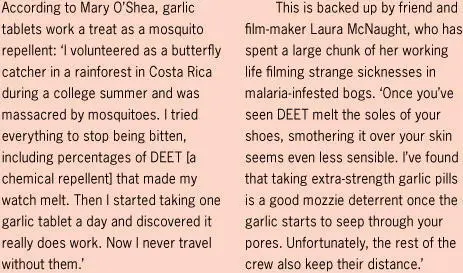
Meningitis
First signs:Flu-like symptoms, but with pain in the limbs; eyes sensitive to light; stiff neck; in an infant the soft spot on the top of the head may be tense or bulging; in the related but much more serious condition septicaemia, a distinctive rash with purple spots develops, sometimes in minutes; if you press a glass over them, the spots do not fade.
Читать дальше
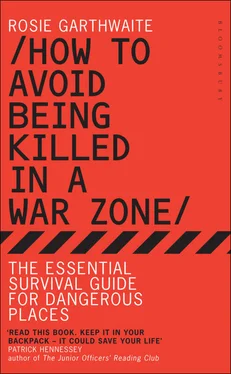

 Meningitis
Meningitis



![Джонатан Димблби - Barbarossa - How Hitler Lost the War [calibre]](/books/385421/dzhonatan-dimblbi-barbarossa-how-hitler-lost-the-w-thumb.webp)



